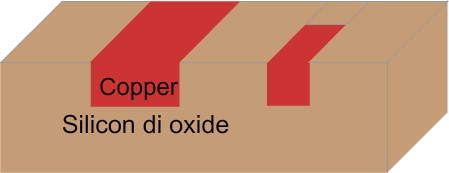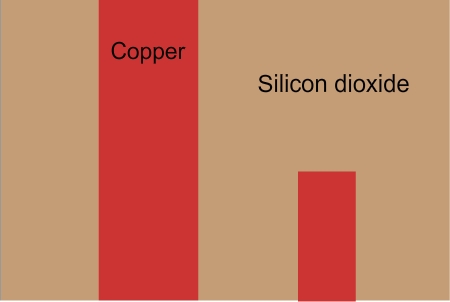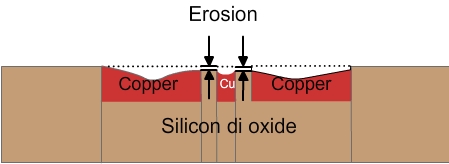Dishing and erosion: Two of the major issues that arise during CMP are dishing and erosion. Consider the set large copper wire shown in figure 4.15. Before planarization, the deposited copper film will look as shown in fig 4.15a. After planarization, ideally, the surface must be flat as shown in fig 4.15b. However, the pad is not a perfectly rigid and straight body and it can in fact bend slightly. Because of that, the copper will be removed as shown in fig 4.15c. This unwanted removal of copper, leading to non planar surface and high resistance wire is called dishing. This occurs especially on wide lines.
 before CMP nv.jpg)
Figure 4.15 a. Schematic of wafer (a) before CMP

Figure 4.15 b. Schematic of wafer after CMP (ideal case)

Figure 4.15 b. Schematic of wafer after CMP (real case). Note the dishing in real CMP.

Figure 4.16 a. Three dimensional view of the lines in figure 6.15 (b).

Figure 4.16 b. Top view of the same structure.
The same wire is shown in the top view in fig 4.16, after ideal planarization. The percentage of area occupied by copper in the top view is called aerial density. To calculate the aerial density , a square of perhaps 10 micron size is usually considered. When the density is higher, dishing and the related issue, erosion, become more likely.
Two samples are shown in Fig. 4.17 a and b.
Copper aerial density is 20%

Copper aerial density is 40%
Fig. 4.17 a and b. Illustrations of locations with different aerial densities. Top view is shown
The loss of silicon dioxide by copper CMP process is called erosion and is illustrated in figure 4.18. When there are many copper lines nearby and in general when the copper aerial density is high, the oxide between the copper is also likely to be removed. This is because the oxide in this area will experience a higher pressure during the CMP process.

Figure 4.18 a. Result of CMP (ideal case).

Fig 4.18 b. Result of real CMP (with Erosion ) Note the erosion i.e. the undesirable loss of oxide
|